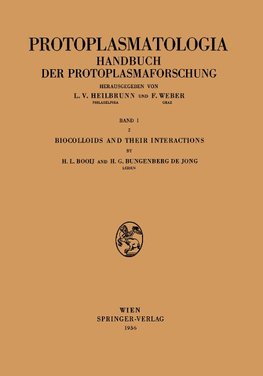
-
 Anglický jazyk
Anglický jazyk
Biocolloids and their Interactions
Autor: Hendrik G. Bungenberg De Jong
1. The R¿le of Colloids in Biological Systems.- References.- 2. Colloid Systems.- References.- 3. Colloids with Electrolytic Nature.- Antagonism of ions.- References.- 4. Complex Systems.- a) Unicomplex systems.- b) Dicomplex systems.- c) Tricomplex systems.-... Viac o knihe
Na objednávku
49.49 €
bežná cena: 54.99 €
O knihe
1. The R¿le of Colloids in Biological Systems.- References.- 2. Colloid Systems.- References.- 3. Colloids with Electrolytic Nature.- Antagonism of ions.- References.- 4. Complex Systems.- a) Unicomplex systems.- b) Dicomplex systems.- c) Tricomplex systems.- d) Some biological examples.- 1. Clotting of blood.- 2. The reaction between antigen and antibody.- 3. Connective tissue.- 4. The protoplasmic membrane.- References.- 5. Association Colloids.- a) Introduction; micelle types.- b) Colloid systems of simple detergents, characterised by the presence of sandwich micelles.- c) The binding of the oppositely charged ion (The sandwich micelle regarded as a complex system).- d) Phosphatides regarded as association colloids.- e) Suitability of phosphatides for biological purposes.- References.- 6. Elastic-Viscous Systems of Association Colloids.- a) Introduction.- b) Viscosity.- c) Elastic-viscous systems are in thermodynamic equilibrium.- d) Characteristic quantities describing the elastic properties.- e) G, ? and ? as a function of the oleate concentration.- f) A comparison of the elastic behaviour of elastic-viscous systems of various soaps.- g) Elastic-viscous systems of long chain electrolytes of the second and third categories (phosphatides).- References.- 7. The Interaction between Organic Substances and Lipophilic Colloid Systems.- a) Introduction.- b) Methods.- c) The activity of aliphatic substances.- Fatty acid anions.- Undissociated fatty acids.- Alcohols.- Hydrocarbons.- Halogen-derivatives.- Ethers.- Sulfides.- Ketones.- Esters.- d) The activity of aromatic (and heterocyclic) substances.- e) The distribution of organic substances in the soap/salt/water system.- f) The influence of alcohols on the fixation of ions.- g) The influence of organic substances on elastic-viscous systems.- h) Biological perspectives.- References.- 8. Interaction between Long Chain Electrolytes and Proteins.- a) Introduction. The coacervation gelatin + detergent + salt.- b) The binding between protein and detergent according to the hypothesis of Pankhurst.- c) The r¿le of the salt necessary for coacervation.- d) The realisation of the coacervation gelatin + cetyltrimethyl-ammonium-bromide + salt.- e) The coacervation gelatin + oleate + K-salt.- f) Particulars of the coacervation gelatin + CTAB + KCNS.- g) Structure and composition of the detergent-rich associations.- h) The loosening effect of alcohols on the association gelatin + detergent.- References.- 9. Biological Membranes.- a) Introduction.- b) Models of the protoplasmic membrane.- 1. The system oil/water.- 2. Porous ¿membranes¿.- 3. Liquid ¿membranes¿.- 4. Monomolecular films.- 5. Complex systems.- 6. Lipophilic coacervates.- 7. Synthetic ¿lipoproteins¿.- c) Theoretical aspects of permeability.- d) Some experiments on the problem of the protoplasmic membrane.- References.- 10. Some Remarks on the Colloid Chemistry of Protoplasm.- a) Colloid morphology.- A. Disintegration of dicomplex coacervate drops in a direct current electric field.- B. Colloid systems surrounded by totally closed membranes.- C. Accumulation of dyes.- b) The submicroscopical structure of cytoplasm.- c) Protoplasmic flow.- References.
- Vydavateľstvo: Springer Vienna
- Rok vydania: 1956
- Formát: Paperback
- Rozmer: 254 x 178 mm
- Jazyk: Anglický jazyk
- ISBN: 9783211804216












